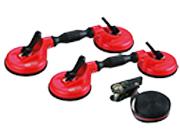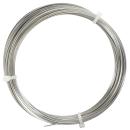Bodywork piano wire

Piano wire for bodywork windscreen
︾
Introduction to piano wire for car bodywork:
Piano wire is a type of high-strength, high-carbon steel wire often used in various fields, including car bodywork. Its technical advantages in the world of bodywork lie mainly in its mechanical properties and versatility. These advantages include
High strength:
Piano wire is characterised by high mechanical strength due to its composition in high-carbon steel. This strength allows it to be used in demanding bodywork applications, where high forces may be involved.
Controlled elasticity :
Piano wire offers some controlled elasticity, meaning it can flex without losing its strength. This makes it useful for applications such as tensioning mechanical parts in the bodywork without risking permanent deformation.
Uniform diameter :
Piano wire is often available with a uniform diameter, making it easy to use in a variety of bodywork applications where a precise dimension is required.
Flexibility:
Although rigid, piano wire can be relatively flexible, making it suitable for applications where shape or tension needs to be adjusted while retaining some rigidity.
Corrosion resistance:
Most piano wire is made from stainless steel or is coated to resist corrosion. This is particularly important in the automotive industry, where parts may be exposed to a variety of weather conditions.
Use in locking and adjustment systems:
Piano wire is often used in locking and adjustment systems for mechanical body parts, helping to ensure a precise and durable assembly.
Varied applications:
Piano wire has a variety of applications in car bodywork, whether to hold parts in place, adjust mechanisms, or ensure the tension of certain components.
Fatigue resistance :
Piano wire is known for its fatigue resistance, i.e. its ability to withstand repeated stresses without significant degradation of its mechanical properties.
In short, piano wire offers a unique combination of strength, controlled elasticity and versatility in automotive bodywork. These properties make it a valuable technical material for a variety of applications requiring mechanical strength and flexibility tailored to the bodywork industry.
Use of bodywork piano wire :
Bodywork piano wire, due to its specific mechanical properties, is often used in various automotive bodywork contexts for applications requiring high strength, controlled flexibility and durability. Here are a few examples of situations where bodywork piano wire can be used to advantage:
Fixing windows and windscreens:
Bodywork piano wire can be used to securely fasten windows and windscreens. It is often used in the glass replacement or repair process to hold these elements reliably in place.
Repair and adjustment of mechanisms :
In door mechanisms, tailgates, bonnets and other body components, piano wire can be used to repair and adjust mechanisms. It can be used to restore the correct tension or to hold specific parts in position.
Locking and latching systems:
Bodywork piano wire can be integrated into locking and latch systems on doors, bonnets or trunks, helping to ensure secure closure and a precise fit.
Tensioning bodywork components:
When repairing bodywork components, piano wire can be used to apply controlled tension. This is particularly useful in scenarios where the original shape of the part needs to be preserved.
Repair of internal structures:
Bodywork piano wire can be used to reinforce and repair internal body structures, helping to maintain the structural integrity of vehicles.
Adjusting body panels:
When bodywork work involves adjusting panels, piano wire can be used to provide controlled tension, allowing bodywork professionals to adjust the shape of panels for precise alignment.
Holding decorative elements in place:
Bodywork piano wire can be used to secure decorative elements or trim to the bodywork, providing a robust fixing solution.
Securing aerodynamic elements:
In the case of aerodynamic elements such as spoilers, piano wire can be used to hold these elements in place, resisting aerodynamic forces.
It is important to note that bodywork piano wire is often used by professional bodywork specialists and requires specific expertise. Installation and use techniques may vary according to specific applications, and it is recommended that you follow the manufacturer's procedures and recommendations.
